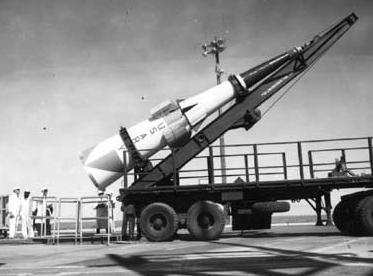Martin Marietta Sprint
The Sprint was a nuclear-armed point defense ABM (Anti-Ballistic Missile), which was developed in the 1960s as one component of an American defense system against Soviet ICBMs. It was operational for a very short time in 1975.
In the late 1950s, the U.S. Army began the development of the XLIM-49A Nike Zeus B exo-atmospheric anti-ballistic missile. While it was definitely desirable to intercept ICBMs at the highest possible altitude to minimize the contamination effects of the interceptor missile's thermonuclear warhead, it was also clear that a terminal defense missile would be needed to catch those reentry vehicles which slipped past the "first line" of defense. After studies in the early 1960s showed that a very-high speed interceptor missile was feasable, Martin Marietta received a development contract for the Sprint missile in March 1963. Component testing began in early 1964, including launches of Squirt experimental missiles. The first Sprint launch occured at WSMR (White Sands Missile Range) in November 1965, and Sprint tests continued at WSMR through 1970.
 |
| Photo: U.S. Army |
| Sprint |
The cone-shaped Sprint missile was powered by a two-stage solid-propellant rocket motor. The motor ignited after the missile had been ejected from its silo by gas pressure, and accelerated the Sprint with more than 100 g. Within seconds, the missile reached a speed of Mach 10+, and the extreme thermodynamic heating demanded sophisticated ablative shielding (the nose was already glowing red-hot less than a second after launch). The Sprint was guided to the target by radio-commands from the ground control system, which used high-speed phased-array MSRs to track the incoming ICBM reentry vehicles. The command uplink had to be powerful enough to work through the exhaust plume and the plasma sheathe around the missile body. Sprint's first stage used fluid-injection jet vanes for control, and the second stage had four small moving fins. The missile was armed with a 1 kT W-66 enhanced radiation thermonuclear warhead, which was detonated by ground command. It destroyed the target's warhead not only with the nuclear blast, but mainly with the very high neutron flux. The whole flight time for an intercept was expected to be not more than 15 seconds.
Full scale testing of the Sprint and the MSR (Missile Site Radar) began in mid-1970, and the first successful intercept of a reentry vehicle by a Sprint occurred in December 1970. A total of about 50 flight tests, the majority being successful, were conducted between this date and December 1973.
 |
| Photo: U.S. Army |
| Sprint |
During the 1960s, the initially planned nation-wide ABM system had been reduced in scope for cost reasons (see also article about LIM-49 Spartan). The final plan, introduced in 1969, was called Safeguard, an ABM system to defend only SAC's ICBM bases, and not the cities of the United States. The SALT I treaty of 1972, and a 1974 addendum, limited Safeguard to only one site with 100 ABMs. On 1 October 1975, the U.S.'s one and only Safeguard ABM site became operational with 30 LIM-49A Spartan and 70 Sprint missiles. However, because the very limited defense offered by a single ABM site did not warrant the costs, the site was deactivated by Congress the next day. About 150 Sprint missiles were built for flight tests and operational deployment.
In May 1971, Martin Marietta had received a contract for an improved missile called Sprint II. This variant would have had an improved guidance system, higher agility and improved reliability, but the Sprint II program did apparently not result in any flight tests. Studies of nuclear armed ABMs were finally ended in 1983.
Designation Note: Several sources (including [2]) explicitly say that Sprint never received a formal missile designation (LIM-nnn). However, it is possible that one of the designations XLIM-99A and XLIM-100A, which were reserved in October 1972, was in fact planned for Sprint (but not taken up for unknown reasons).
Specifications
Note: Data given by several sources show slight variations. Figures given below may therefore be inaccurate!
Data for Sprint:
| Length | 8.20 m (26 ft 11 in) |
| Diameter | 1.35 m (4 ft 5 in) |
| Weight | 3500 kg (7700 lb) |
| Speed | Mach 10+ |
| Ceiling | 30000 m (100000 ft) |
| Range | 40 km (25 miles) |
| Propulsion | 1st stage: Hercules X-265 solid-fueled rocket; 2900 kN (650000 lb) for 1.2 s 2nd stage: Hercules X-271 solid-fueled rocket |
| Warhead | W-66 thermonuclear (1 kT) |
Main Sources
[1] James N. Gibson: "Nuclear Weapons of the United States", Schiffer Publishing Ltd, 1996
[2] Bill Gunston: "The Illustrated Encyclopedia of Rockets and Missiles", Salamander Books Ltd, 1979
[3] R.T. Pretty, D.H.R. Archer (eds.): "Jane's Weapon Systems 1972-73", Jane's, 1973
[4] Mark Paine: Nuclear ABMs of the USA
Back to Directory of U.S. Military Rockets and Missiles, Appendix 4
Last Updated: 5 October 2004